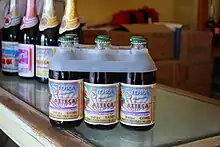.jpg.webp)
Package handles, or carriers, are used to help people use packaging. They are designed to simplify and to improve the ergonomics of lifting and carrying packages.[1][2][3][4] Handles on consumer packages add convenience and help facilitate use and pouring. The effect of handles on package material costs and the packaging line efficiencies are also critical. A handle can be defined as “an accessory attached to a container or part for the purpose of holding or carrying.”[5] Sometimes a handle can be used to hang a package for dispensing or use.
Handles can be built into a package, sometimes in the form of hand holes or hand holds. They can also be attached to a finished complete package after filling and closing, or even at the point of purchase.
The performance and design criteria for handles are often detailed in a contract or specification. For example handles for some US government containers are specified in Mil-Std-648.[6]
History
People have long seen a need to have package forms which are easy for people to carry and to use. Some of these, such as amphora,[7] date from the Neolithic period. Handles have been formed into packages and containers such as pottery and stoneware. Wire, rope, and wicker have been added when needed.
Boxes
Wooden boxes often have hand holes or attached metal handles to facilitate handling. Steel boxes also frequently have attached handles or hinged bails.
Corrugated boxes can have hand holes die-cut into the ends to assist material handling tasks.[8] Several designs are in use.[9][10] Care must also be taken for the hand holes not to weaken the strength of the box.[11][12][13]
Depending on the contents and the degree of handling required, reinforcement is sometimes needed to prevent tearing. Reinforcing tapes, whether pressure -sensitive or heat-activated, can be applied to boxes in the vicinity of hand holes.[14][15]
Separate plastic or composite fitments are also available for corrugated boxes.[16][17]
 Telescope box used for bananas. Note hand holes and ventilation holes
Telescope box used for bananas. Note hand holes and ventilation holes Handles on a metal ammunition box
Handles on a metal ammunition box.jpg.webp) Boxes of Greek laundry detergent with handles
Boxes of Greek laundry detergent with handles Corrugated tray of tomatoes at a farmers market
Corrugated tray of tomatoes at a farmers market Box wine with a plastic handle inserted into holes in the top of the corrugated box
Box wine with a plastic handle inserted into holes in the top of the corrugated box
Plastic bottles
Many plastic containers have built in handles. Plastic shipping containers and storage tubs often have handles moulded into them. Consumer blow moulded containers often have integral handles or are shaped to facilitate grasping.[18][19] Hot water bottles often have a handle or hole for hanging.
 bulk soy sauce with handle on top
bulk soy sauce with handle on top Blow molded plastic bottle of milk with indentations for a handle
Blow molded plastic bottle of milk with indentations for a handle HDPE plastic bottle of milk, one US gallon
HDPE plastic bottle of milk, one US gallon large reusable plastic bottles of water
large reusable plastic bottles of water Drain cleaner with convenience handle
Drain cleaner with convenience handle
Separate handles are sometimes added to a bottle, usually around the neck at the closure. This simplifies the bottle forming process and can allow use of lighter weight bottles. Several methods have been developed.[20][21][22][23][24]
 bottle of apple juice with added handle
bottle of apple juice with added handle PETE water bottle with attached handle
PETE water bottle with attached handle Clip used to join two spray bottles and to provide a handle
Clip used to join two spray bottles and to provide a handle
Bags
Many types of bags have handles to assist in carrying them. Paper, fabric, and plastic shopping bags frequently have handes to assist shoppers carry difficult loads. Large bulk bags can have lifting straps or hand-holds to allow people or equipment to lift or stabilize the load.
 Kraft paper bags with handles
Kraft paper bags with handles A blue reusable shopping bag
A blue reusable shopping bag Plastic bag of water softener salt; handle die-cut through the thick plastic to allow carrying
Plastic bag of water softener salt; handle die-cut through the thick plastic to allow carrying FIBC: bulk bag with lifting straps
FIBC: bulk bag with lifting straps
Multi-packs of beverage containers
Shrink wrapped Multi-packs often have open ends (bulls eyes) which can be used as handles. Methods are available to reinforce the film, if needed.[25][26] Handles are often used on beverage carriers.
 Shrink wrapped pack of bottles with ends (bulls eyes) as handles
Shrink wrapped pack of bottles with ends (bulls eyes) as handles Six-pack rings for beverage cans
Six-pack rings for beverage cans Paperboard basket
Paperboard basket Plastic six-pack carrier
Plastic six-pack carrier
Tape handle

Pressure sensitive tape is often used as a handle: filament tape or heavy-duty plastic film backed tapes (polypropylene or polyester). A loop can be applied over a package with paper or film used to cover the adhesive in the center portion.
Another example with a shrink film package is for a tape to be applied to a film with slits cut in the film on either side of the tape. When the film shrinks, the tape does not and a handle is formed.[27] More common ( shown in photo) is for a tape strip with center portion matted out to be applied to shrink film prior to wrapping items. Again, the film shrinks but the tape does not, raising the matted out portion.
PSA tape handles can be built into a box or bag structure or can also be added after package completion.[28] Specialized application machinery is sometimes available.[29]
Bail handle
A bail handle consists of an open loop with ends attached to the item or package, sometimes to fixed mounts or ears. Several designs are available: bails are typically made of metal (wire) or plastic. It is a type of package handle which may be used for carrying or hanging items such as cans, pails, or jars.
Testing
Several package testing options are available to packaging engineers to help determine the suitability of package handles.
People can be used directly in an evaluation. Several different people can carry (and even abuse) handle and package options for subjective ratings. These can be compiled in a report.[30]
More objective laboratory procedures are also used. Fixtured ‘’hands’’ of various designs are used to hold a handle (sometimes two handles for a box). ASTM International D6804, Standard Guide for Hand Hole Design in Corrugated Boxes, describes “jerk testing’’ by modified drop test procedures or use of the constant pull rates of a Universal testing machine. ASTM F852, Specification for Portable Gasoline, Kerosene, and Diesel Containers for Consumer Use, requires severe "jerk testing" of the handle. These test procedures are also used on other types of packages.[31][32] Other test procedures are conducted with a static force by hanging a heavily loaded package for an extended time or even using a centrifuge.[33][34]
See also
References
- ↑ Ergonomic Guidelines for Manual Material Handling (PDF), California Department of Industrial Relations, 2007, p. 32, retrieved April 2, 2019
- ↑ Davis, K G (1998). "Reduction of spinal loading through the use of handles" (PDF). Ergonomics. 41 (8): 1155–1168. doi:10.1080/001401398186450. PMID 9715674. S2CID 35062317. Archived from the original (PDF) on 2019-02-27. Retrieved March 23, 2019.
- ↑ Wang, Mao-Jiun J. (Winter 2000). "The Effect of Handle Angle on MAWL, Wrist Posture, RPE, and Heart Rate". Human Factors. 42 (4): 553–565. CiteSeerX 10.1.1.1000.7796. doi:10.1518/001872000779698079. PMID 11324850. S2CID 7243355.
- ↑ Shih, Yuh-CHuan (1997). "Phychophisical Evaluation of Diameter and Angle of Container Handles". International Journal of Industrial Ergonomics. 19: 347–344. Retrieved 12 February 2021.
- ↑ Soroka, W (2008). Glossary of Packaging Terminology. IoPP. p. 103. ISBN 978-1-930268-27-2.
- ↑ MIL-STD-648D, DEPARTMENT OF DEFENSE DESIGN CRITERIA STANDARD, SPECIALIZED SHIPPING CONTAINERS (PDF), 10 April 2008, pp. section 4.17, retrieved 26 April 2018
- ↑ Twede, D (2002), "Commercial Amphoras: The Earliest Consumer Packages?", Journal of Macromarketing, 22 (1): 98–108, doi:10.1177/027467022001009, S2CID 154514559, retrieved 19 June 2019
- ↑ Nogueira, H C (2018). "Adding Handles to Optimize Manual Box Handling". BioMed Research International. 2018: 7315217. doi:10.1155/2018/7315217. PMC 6276528. PMID 30581864.
- ↑ ASTM D6804 Standard Guide for Hand Hole Design in Corrugated Boxes, ASTM International, 2015
- ↑ US 3094268, Swanson, Elmer G. & Hyland, William C., "Carrying handle construction for cartons", published 1963-06-18, assigned to St. Regis Paper Co.
- ↑ Han, Jongkoo; Park (January 2007). "Finite element analysis of vent/hand hole designs for corrugated fibreboard boxes". Packaging Technology and Science. 20 (1): 39–47. doi:10.1002/pts.741.
- ↑ Singh, J (2008), "The Effect of Ventilation and Hand Holes on Loss of Compression Strength in Corrugated Boxes", J Applied Packaging Research, 2 (4): 227–238, retrieved 2 April 2018
- ↑ US 4037777, Maughan, William G., "Handhole closure for containers", published 1977-07-26, assigned to Westvaco Corp.
- ↑ US 4567070, Karass, Thomas J., "Fibrous material reinforcing tape, method of making the same and containers reinforced by said tape", published 1986-01-28
- ↑ US 4817866, Wonnacott, Roger J., "Packaging", published 1989-04-04, assigned to St. Regis Packaging Ltd.
- ↑ US application 2004007612, Johanson, James; Antal, Keith & Rigney, Thomas, "Box hand hole reinforcement and method of use", published 2004-01-15, now abandoned.
- ↑ US 3774836, Nunn, Frank C., "Carton having tape handle", published 1973-11-27, assigned to The Procter & Gamble Co.
- ↑ Birkby, David (May 2014). "PET bottle handle—N.A. success story". Canadian Packaging. Retrieved 29 May 2018.
- ↑ Widiyati, Khusnun (2013). "The Ease of Grasping to Evaluate Aesthetically Pleasing PET Bottle Design". Journal of Advanced Mechanical Design, Systems, and Manufacturing. 7 (5): 849–861. doi:10.1299/jamdsm.7.849. Retrieved April 1, 2019.
- ↑ US 4231605, Newman, Fred C., "Carrier assembly for multi-pack containers", published 1980-11-04, assigned to The Continental Group Inc.
- ↑ US 4509639, Thompson, Mortimer S., "Multi-container carrier package and a method of assembly therefor", published 1985-04-09, assigned to Tri-Tech Systems International Inc.
- ↑ US 4093295, Erickson, Gerald, "Bottle carrier", published 1978-06-06, assigned to International Omni-Pak Corp.
- ↑ US 4257525, Thompson, Mortimer S., "Bottle with attached handle", published 1981-03-24
- ↑ US 5788302, Barrash, Marshall J. & Ferguson, Earl B., "Bottle carrier", published 1998-08-04, assigned to The Coca-Cola Co.
- ↑ US 7775349, Walker, Terry D., "Shrink-wrap packaging incorporating reinforced integral handle", published 2010-08-17, assigned to Millercoors LLC
- ↑ US application 2007215504, Walker, Terry, "Shrink-wrap packaging incorporating reinforced integral handle", published 2007-09-20, assigned to Millercoors LLC, now abandoned.
- ↑ US 4700528, Bernard, Emile C., "Heat shrink package handle", published 1987-10-20, assigned to Minnesota Mining & Manufacturing Co.
- ↑ US 3031359, Blank, Lawrence & Capella, Primo J., "Pressure-sensitive adhesive tape handle construction", published 1962-04-24
- ↑ US 5186542, Seabold, Thomas W., "Tape handle for a container and method for construction thereof", published 1993-02-16, assigned to Minnesota Mining & Manufacturing Co.
- ↑ Diringer, J. A. (2016). Evaluation of Durability of Nonwoven Polypropylene Grocery Bags Under Routine Use (MSc). Clemson University. Retrieved April 2, 2019.
- ↑ US 4269322, Larson, Curtis L., "Flexible bail assembly", published 1981-05-26, assigned to Minnesota Mining & Manufacturing Co.
- ↑ Diringer, J. A. (2016). Evaluation of Durability of Nonwoven Polypropylene Grocery Bags Under Routine Use (MSc). Clemson University. Retrieved April 2, 2019.
- ↑ US 4991444, Dodd, Clayton, "Centrifugal carton test method and apparatus", published 1991-02-12, assigned to Manville Corp.
- ↑ US 4553438, Dawson, Raymond L.; Dodd, Clayton & Harrell, Bobby E. et al., "Centrifugal carton tester", published 1985-11-19, assigned to Manville Service Corp.
Further reading
- Yam, K. L., "Encyclopedia of Packaging Technology", John Wiley & Sons, 2009, ISBN 978-0-470-08704-6


_-_NARA_-_541753.jpg.webp)


